- Joined
- Nov 26, 2009
- Messages
- 3,280
Everyone already knows that the 850 guides are too big and impede the flow.
Below is a diagram showing how the port was simply bored out to 32mm up to the guide leaving a choke down ridge at the middle of the guide where it necks down to 30mm. This is the opposite of what you want because the guide area is the restriction point. This is why R10 850 heads run better with their 30mm ports. Its better to have a venturi leading up to the guide with the port at least the same size or a little wider at the guide to help breathing. Both the RH4 and the RH10 heads have the same port diameter between the guide and the bowl. The bowl also being the same size. You can feel a 1mm ridge of reduced diameter if you run your finger down an RH4 port all the way into the guide area.
The best option is to sleeve the RH4 ports down to 30mm ID all the way to the guide. You can DIY with the right size tubing or machine your own.

Below is a diagram showing how the port was simply bored out to 32mm up to the guide leaving a choke down ridge at the middle of the guide where it necks down to 30mm. This is the opposite of what you want because the guide area is the restriction point. This is why R10 850 heads run better with their 30mm ports. Its better to have a venturi leading up to the guide with the port at least the same size or a little wider at the guide to help breathing. Both the RH4 and the RH10 heads have the same port diameter between the guide and the bowl. The bowl also being the same size. You can feel a 1mm ridge of reduced diameter if you run your finger down an RH4 port all the way into the guide area.
The best option is to sleeve the RH4 ports down to 30mm ID all the way to the guide. You can DIY with the right size tubing or machine your own.

Last edited:



